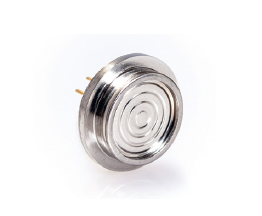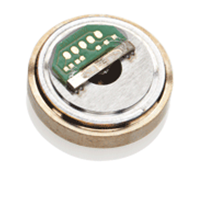Front-flush pressure sensors for viscous and solids-containing media
Common pressure transmitters have a pressure channel hole located between the process connection and the diaphragm of the actual pressure sensor. If liquids with high viscosity or with solids in them are to be measured, this bore can become clogged, and the pressure measurement is impaired. The sensor can even be damaged. Therefore, flush pressure sensors are used in such cases. This article explains the most important types of flush-mounted sensors, their advantages and disadvantages as well as their areas of application.
All pressure transmitters with flush-mounted sensors enable a dead-space-free seal as well as easy cleaning of all surfaces in contact with the medium. This is particularly crucial in applications where the measured medium is changed, and cross-contamination must be avoided. Pressure transmitters with flush diaphragms are often used for level measurement. The hydrostatic pressure created by the liquid in the tank is not high in most applications; 1 bar corresponds to a level of around 10 metres for water. When used to measure pressure in pump systems, a somewhat higher pressure range is required, usually between 10 and 100 bar.
Piezoresistive pressure sensors
The most common type of flush pressure transmitter is the one with piezoresistive sensors. The actual sensor element is a silicon measuring element embedded in oil. This oil, usually a silicone oil, acts as a pressure transmission medium and is protected from the measured medium by a separating diaphragm with a characteristic wave structure. Only the separating membrane encounters the medium, but it must be very thin so as not to influence the measured value.
The advantage of piezoresistive sensors is their high sensitivity, thanks to which low measuring spans and higher accuracies are possible. They are suitable for measuring absolute pressure and relative pressure with measuring spans of less than 100 mbar pressure up to several 100 bar. The separating diaphragm can be made of different materials and even coated if desired. The standard version is usually made of steel 1.4435 (AISI316L). Alternatively, there are variants in corrosion-resistant materials such as nickel alloys or titanium. Piezoresistive sensors are well suited for homogeneous, rather pasty media and for liquids that contain no or only small, soft solids. Hard particles can damage the very thin separating membrane, which is only approx. 20 - 70 micrometres thick, and thus lead to an irreversible signal offset. If the membrane is not only deformed but even punctured, the oil of the pressure sensor leaks out and can contaminate the entire system, depending on the application. Another disadvantage of piezoresistive sensors is the lower long-term stability of the silicon under elevated temperatures. This can lead to signal drift.




Ceramic pressure sensors
Ceramic pressure sensors are ideally used when the liquid to be measured contains abrasive parts or hard solids. This is because the ceramic measuring membrane is very hard and resistant to corrosion from most media in technical applications. In ceramic pressure sensors, a resistance bridge is located on the back of a thin ceramic plate, which is attached to the likewise ceramic sensor base body via a glass-like, extraordinarily robust connection. The entire ceramic sensor is fixed in the metal housing of the transmitter and sealed by means of an elastomer seal, usually an O-ring. The metal housing can be made of a wide variety of materials. In addition to various alloys of stainless steel, Trafag also offers versions in titanium for maximum corrosion resistance. Ceramic pressure sensors are suitable for measuring absolute and relative pressure and measuring spans from around 100 mbar up to around 400 bar. While at low measuring spans (less than 2 bar) the ceramic diaphragm is also thin and sensitive, a much thicker diaphragm can be used for larger measuring spans. This also offers a certain resistance to incorrect manipulations such as cleaning with hard objects, for example steel brushes or screwdrivers. The separating diaphragm of the piezoresistive sensor, on the other hand, is always approximately the same thickness and correspondingly sensitive. The main disadvantage of ceramic sensors is their lower accuracy, and the fact that it is not welded directly to the housing but is only connected to it via elastomer seals. By design, the elastomer seal always requires a small step or recess, which makes it impossible to achieve an absolutely smooth surface as with piezoresistive or thin-film-on-steel sensors.
Thin-film-on-steel pressure sensors
Flush-mounted thin-film-on-steel sensors offer maximum long-term stability due to the sputtered-on resistance bridges. The membrane is welded directly to the transmitter housing. It is significantly thicker and more resistant than piezoresistive sensors, but not quite as insensitive to high pressure as ceramic sensors. Front-flush steel sensors are therefore suitable for measuring the pressure of viscous, pasty and adhesive media as well as media containing solids. They are also used for liquids with particles that are slightly abrasive and offer good resistance to harder solids. In the case of crystallising liquids such as freezing water, they offer the advantage of being significantly more robust against volume expansion than piezoresistive and ceramic sensors due to the ductile, i.e. very elastic, membrane material. This means that they are better able to prevent leakage in the event of damage due to overpressure in the medium or the expansion of freezing liquids. Flush-mounted thin-film-on-steel sensors are, however, not very widespread so far, because their production is very demanding and is only mastered by very few suppliers. In addition, the alloy of steel 1.4542 (17-4PH) usually used for thin-film-on-steel sensors has only limited corrosion resistance.


Are you looking for flush-mounted pressure transmitters? Are you unsure which sensor is best suited for your application? Please contact us. Our specialists will be happy to advise you and work with you to find the best solution.
Flush Membrane Transmitter
Trafag not only has the necessary knowledge to manufacture and process flush-mounted thin-film-on-steel sensors, but also offers the flush-mounted pressure transmitter FPT 8236, a pressure sensor made of corrosion-resistant duplex steel: The diaphragm steel used, with DIN number 1.4462, offers very high resistance to many corrosive liquids, including salt water. The FPT 8236 transmitter with flush diaphragm is suitable for measuring relative pressure from 1 bar to 100 bar measuring span.




